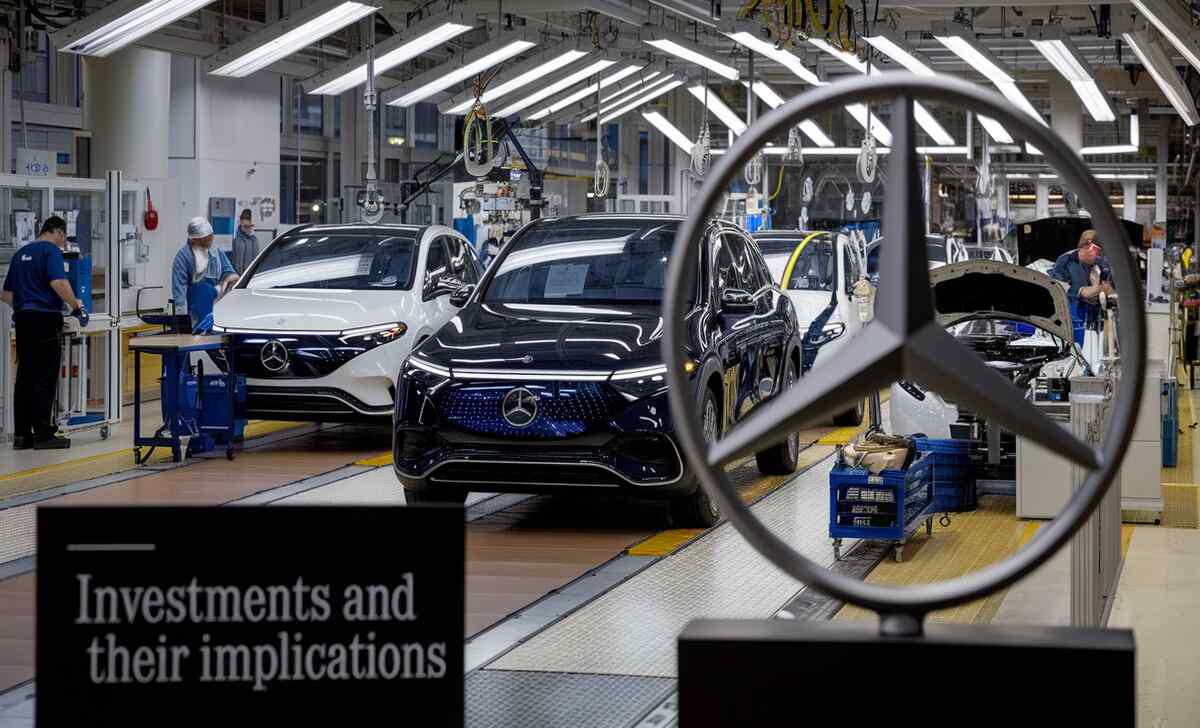Mercedes-Benz Group AG has released its latest quarterly earnings report, providing valuable insights into its financial performance amid a complex economic landscape.
The company faced revenue and net income declines due to weaker macroeconomic conditions, intense competition- especially in Asia- and ongoing product transitions. Despite these challenges, Mercedes-Benz demonstrated resilience with solid cash flow generation and strategic investments in electric vehicle (EV) development.
Analysts had forecast a tough quarter, yet the company managed to exceed expectations for earnings per share (EPS), signaling effective cost control and efficiency measures. This report delves into the company’s key financial highlights, revenue trends, divisional performance, stock market outlook, and strategic initiatives aimed at long-term sustainability.

Key Takeaways:
- Revenue Decline: €34.5 billion (-6.7% YoY) due to weaker demand and product transitions.
- EPS Resilience: €1.81, exceeding analyst forecasts despite a 52% net income drop.
- EV Investments: Strong focus on battery tech and charging infrastructure.
- Free Cash Flow: €2.39 billion, supported by cost control measures.
- Stock Outlook: Volatile but supported by efficiency gains and premium model sales.
- Dividend Strategy: Commitment to payouts alongside a share buyback program.
Highlights On The Latest Quarterly Earnings Report

Mercedes-Benz Group AG’s latest quarterly earnings report highlights the company’s resilience amid tough market conditions. Despite declining sales volumes and pricing pressures, the company demonstrated solid cash generation, focusing on efficiency increases and cost improvement to navigate challenges.
Key Financial Highlights:
- EPS: €1.81, slightly above analyst estimates
- Net Income: Down 52% year-over-year
- Revenue: €34.5 billion, a 6.7% decline
- Key Challenges: Product transitions, lower sales, and market shifts
Earnings Per Share (EPS) Overview

EPS is always a hot topic, and this quarter was no different. Despite the overall financial slowdown, Mercedes-Benz managed to exceed analyst forecasts.
This slight overperformance in EPS shows that the company is still navigating difficult economic conditions better than expected. However, the decline in net profit highlights the ongoing pressures faced by the company.
Revenue Performance Analysis
Revenue figures indicate a downward trend, with unit sales seeing a dip across multiple markets. The European Union remained a core sales region, though the impact of financial services and cost improvement initiatives played a crucial role in mitigating deeper losses.
Lower sales volumes and product transitions affected the company’s ability to maintain the same level of group revenue as the previous year.
Investments And Their Implications

Mercedes-Benz Group continues to prioritize investments, particularly in electric vehicle (EV) development. This quarter saw significant capital investments in battery technology and charging infrastructure. However, these investments, while necessary for long-term growth, also contributed to lower operating income in the short term.
Free Cash Flow Analysis
Despite revenue challenges, free cash flow remained relatively strong at €2.39 billion. This was supported by solid cash generation and favorable working capital management. The Chief Financial Officer emphasized that cost control measures are in place to ensure long-term financial stability.
Net Liquidity Position
Net liquidity stood at €28.73 billion, slightly above the previous year. Cash equivalents helped maintain a strong financial base, ensuring the company has the flexibility to navigate uncertain stock market conditions.
Divisional Performance Insights

Mercedes-Benz Cars saw lower sales volumes due to product transitions, while Mercedes-Benz Vans benefited from cost improvements and strong unit sales. Financial Services maintained stable operating income despite challenging market conditions.
Mercedes-Benz Cars Results
The Mercedes-Benz Cars division experienced a decline in unit sales, mainly due to weaker demand in the Asian market and the transition to new internal combustion engine (ICE) and battery electric vehicle (BEV) models.
While overall sales volume dipped, high-end luxury models, such as the S-Class and AMG variants, maintained strong demand, helping offset some of the impact on group revenue. However, lower net pricing and market conditions weighed on profitability.
Mercedes-Benz Vans Performance
Unlike the car segment, Mercedes-Benz Vans performed better than expected, delivering solid cash flow and a higher-than-anticipated adjusted return. Strong demand for commercial and electric vans, combined with disciplined pricing and cost-efficiency strategies, contributed to this positive performance.
The division continued expanding its market share, particularly in the European Union, reinforcing its position as a key driver of earnings for the company.
Mobility Divisional Dynamics
The Mercedes-Benz Financial Services division provided stability amid fluctuating sales volumes. Despite lower vehicle sales, the segment maintained a steady operating income, supported by leasing and financing activities.
The use of non-GAAP measures helped refine profitability outlooks, ensuring a clearer understanding of long-term financial performance. The company continues to invest in digital mobility solutions, aiming to enhance customer experience and strengthen its financial services portfolio.
Stock Performance Outlook

Mercedes-Benz’s stock performance is expected to remain volatile as the company navigates market conditions, cost-efficiency measures, and EV investments.
While revenue pressures persist, strategic cost-cutting and a focus on high-margin models could help stabilize investor confidence. Additionally, Federal Reserve policies and global economic trends will influence stock trends in the coming quarters.
Key Factors Influencing Stock Trends:
- Market Conditions: Economic slowdowns and inflation impact consumer demand.
- Federal Reserve Policies: Interest rate changes affect investment flows.
- Efficiency Gains: Cost-cutting measures drive operating income growth.
- EV Demand: Expanding the Mercedes-Benz Cars and Mercedes-Benz Vans electric lineup influences future sales.
- Product Mix Adjustments: Prioritizing luxury and high-margin models boosts group revenue.
Share Buyback Policies And Dividends

Mercedes-Benz’s share buyback program aims to stabilize stock prices and enhance earnings per share (EPS). Despite challenging market conditions, the company remains committed to dividend payouts, leveraging free cash flow to maintain shareholder value while balancing cash flows and future investments.
Share Buyback Initiative
Mercedes-Benz has launched a strategic share buyback program to enhance stock market performance and return value to investors. By repurchasing shares, the company reduces the number of outstanding stocks, which can help stabilize stock prices and improve earnings per share (EPS). This approach reflects confidence in the company’s long-term financial performance and ability to generate solid cash flow.
Dividend Strategy And Impact On Shareholders
Despite challenging market conditions, Mercedes-Benz remains committed to dividend payouts as part of its strategy to reward shareholders. The company aims to balance cash flows, reinvest in growth initiatives, and ensure consistent returns. While lower sales volumes and net income declines pose challenges, the company’s strong free cash flow supports a sustainable dividend policy, reinforcing investor trust.
Technical Analysis Of Stock Performance
Mercedes-Benz’s stock has experienced fluctuations due to market conditions, financial performance, and analyst estimates. Despite a 6.7% revenue decline and a 52% drop in net income, strong free cash flow generation has helped stabilize investor sentiment.
Quarterly projections indicate continued volatility, with stock trends influenced by cost improvements, EV demand, and global economic factors. Analyst forecasts remain cautiously optimistic, expecting gradual recovery as market conditions improve.
Key Figures Overview:
- Revenue: €34.5 billion (-6.7% YoY)
- Net Income: €1.73 billion (-52% YoY)
- Free Cash Flow: €2.39 billion (slightly higher than Q3 2023)
Analyst Ratings And Recommendations:
- Most analysts rate Mercedes-Benz as a “Moderate Buy.”
- Stock recovery potential in future quarters, driven by cost efficiency and premium model sales.
- Concerns over global economic conditions and pricing pressures remain.
FAQs
1.Why Did Mercedes-Benz’s Revenue Decline This Quarter?
The decline was due to weaker macroeconomic conditions, intense competition in key markets like Asia, and product transitions affecting the sales mix.
2.How Did Mercedes-Benz’s EPS Exceed Expectations Despite Lower Revenue?
Effective cost management and efficiency measures helped mitigate losses, leading to an EPS slightly above forecasts.
3.What Is The Company Doing To Address Lower Sales Volumes?
Mercedes-Benz is focusing on strategic pricing, expanding EV production, and implementing cost-efficiency initiatives to counteract lower sales volumes.
4.How Does Free Cash Flow Remain Strong Despite Revenue Declines?
Favorable working capital management and a disciplined financial approach have ensured a positive free cash flow.
5.What Is The Long-Term Outlook For Mercedes-Benz Stock?
Analysts predict fluctuations but expect recovery as the company advances in EVs and cost-control measures.
6.How Do Product Transitions Impact Earnings?
The introduction of new models affects sales distribution, causing temporary dips in revenue and net profit.
7.What Are The Main Challenges Mercedes-Benz Faces In The Current Market?
The company is contending with a challenging market environment, including economic uncertainties and competitive pressures, particularly in the luxury segment.
8.How Is Mercedes-Benz Adapting To The Growing Demand For Electric Vehicles?
Mercedes-Benz is investing heavily in its electric vehicle lineup, aiming to capture a significant share of the growing EV market.
9.What Measures Are Being Taken To Improve Profitability In The Coming Quarters?
The company plans to implement further efficiency increases and cost improvements across the business to enhance profitability.